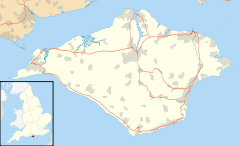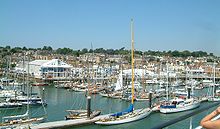- Cowes
-
This article is about the town on the Isle of Wight. For the town on Phillip Island, Australia, see Cowes, Victoria.
Coordinates: 50°45′34″N 1°18′01″W / 50.7595°N 1.3002°W
Cowes 
Cowes Harbour
 Cowes shown within the Isle of Wight
Cowes shown within the Isle of WightPopulation 9,663 [1] OS grid reference SZ493958 Unitary authority Isle of Wight Ceremonial county Isle of Wight Region South East Country England Sovereign state United Kingdom Post town COWES Postcode district PO31 Dialling code 01983 Police Hampshire Fire Isle of Wight Ambulance Isle of Wight EU Parliament South East England UK Parliament Isle of Wight List of places: UK • England • Isle of Wight Cowes (sometimes anachronistically referred to as West Cowes) is an English seaport town and civil parish[2] on the Isle of Wight. Cowes is located on the west bank of the estuary of the River Medina facing the smaller town of East Cowes on the east Bank. The two towns are linked by the Cowes Floating Bridge, a chain ferry.
The population was 9,663 in the 2001 census,[1] a figure that is easily doubled during the regatta in early August.
Leland's 19th century verses described the towns poetically as "The two great Cowes that in loud thunder roar, This on the eastern, that the western shore".
Cowes has been seen as a home for international yacht racing since the founding of the Royal Yacht Squadron in 1815. The town gives its name to the world's oldest regular regatta, Cowes Week, which occurs annually in the first week of August. Later on in the summer, powerboat races are held.
Much of the town's architecture is still heavily influenced by the style of ornate building which Prince Albert popularised.
Contents
Transport
Cowes is a gateway town for the Isle of Wight. Travellers to Southampton are served by a high speed catamaran passenger ferry from Cowes known as the Red Jet. Southern Vectis route 1 is the main bus service in Cowes, serving the Red Jet terminal and running to Newport to take travellers on to other Island destinations.[3] Wightbus also run local services around Cowes and Gurnard. The Cowes Floating Bridge connects the two towns of Cowes and East Cowes throughout the day. It is one of few chain ferries left not to have been replaced by a physical bridge.
Cowes is the start of the Isle of Wight Coastal Path.[4]
Cowes was once served by Cowes railway station on the Island Line. However, this was closed as part of the Beeching Axe.[citation needed]
History
Name
The name Westcowe was attested in 1413 as the name of one of two sandbanks, on each side of the River Medina estuary, so-called after a supposed likeness to cows. The name was subsequently transferred to fortifications built during the reign of Henry VIII on the east and west banks of the river to dispel a French invasion, referred to as cowforts or cowes. They subsequently gave their names to the towns of Cowes and East Cowes, replacing the earlier name of Shamblord.
The towns name has been subject to dispute in the past, sometimes being called Cowes, and then West Cowes. For example a Milestone from the 17th century exists, calling the town Cowes, but up until the late 19th Century the Urban District Council bore the name West Cowes. 1895 saw the last major point where the town was called West Cowes, when West Cowes Urban District Council applied for permission to change the name of the town to Cowes officially, and this was granted on the 21st of August 1895.[5] Despite the vast majority of businesses and people in the town in the past century calling it Cowes, the name West Cowes is still contentiously used throughout the literature of Red Funnel, the ferry provider that provides routes from Southampton to Cowes and East Cowes.
Early history
In earlier centuries the two settlements were much smaller and known as East and West Shamblord, the East being the more significant settlement.
The Isle of Wight was a target of attempted French invasions, and there were notable incursions. Henrician Castles were built in both settlements in the sixteenth century. The west fort in Cowes still survives to this day, albeit without the original Tudor towers, as Cowes Castle. The fort built in East Cowes is believed to have been similar but was abandoned c1546 and since destroyed.
Royal patronage creates a yachting centre
It is believed that the building of an 80 ton, 60 man vessel called Rat O'Wight[6] on the banks of the river Medina in 1589 for the use of Queen Elizabeth I sowed the seed for Cowes to grow into a world renowned centre of boat-building. However, seafaring for recreation and sport remained the exception rather than the rule until much later. It was not until the reign of keen sailor George IV that the stage was set for the heyday of Cowes as 'The Yachting Capital of the World.' In 1826 the Royal Yacht Squadron organised a three-day regatta for the first time and the next year the king signified his approval of the event by presenting a cup to mark the occasion. This became known as Cowes Regatta and it soon grew into a four-day event that always ended with a fireworks display.
Great houses
In Cowes the 18th century house of Westbourne was home to a collector of customs whose son, born there in 1795, lived to become Dr Thomas Arnold, headmaster of Rugby School.
Northwood House was the home of the Ward family. It was donated under trust to the town in 1929, the grounds becoming Northwood Park. William George Ward was a close friend of the poet Tennyson and in whose memory the poet wrote six lines.
Cowes and East Cowes became a single urban district in 1933.
World War II and the Blyskawica
During an air raid of World War II on 4/5 May 1942, the local defences had been fortuitously augmented by the Polish destroyer Blyskawica (itself built by White's in East Cowes), which put up such a determined defence that, in 2002, the crew's courage was honoured by a local commemoration lasting several days to mark the 60th anniversary of the event. In 2004 an area of Cowes was named Francki Place in honour of the ship's commander.[7] The Friends of the ORP Błyskawica Society is active in Cowes.
Economy
Local industry in both Cowes and East Cowes has always centred on the building and design of marine craft and materials associated with boat-making, including the early flying boats, and sail-making. It is the place where the first hovercraft was tested.
Major present-day employers include BAE Systems Integrated System Technologies (Insyte), which occupies the site of the old Somerton Aerodrome at Newport Road, Cowes; and GKN Aerospace in East Cowes.
The population of the town increases dramatically during Cowes Week, and becomes the busiest time of the year for local businesses. The town has recently been reported to be doing well, despite the economic downturn.[8]
Notable residents
- Ellen MacArthur - solo long-distance yachtswoman
- Alan Titchmarsh - gardener, novelist and broadcaster
- Princess Zita of Bourbon-Parma, future Empress of Austria-Hungary was educated at a nearby convent as a young girl
- Dr Thomas Arnold — Headmaster of Rugby School
- Jeremy Irons — film actor and Oscar and double-Emmy winner
- Cliff Michelmore — BBC television and radio presenter/producer
- Mark King — bassist and lead singer of Jazz/Funk Fusion band Level 42
- Albert Ketèlbey — composer, conductor and pianist
- Kenneth Kendall — journalist and broadcaster
- Celia Imrie — actress
- Uffa Fox — naval architect, author, yachtsman
See also
- Cowes Maritime Museum
- Holy Trinity Church, Cowes
- St. Mary's Church, Cowes
- St. Faith's Church, Cowes
References
- ^ a b Census 2001
- ^ English Parishes & Welsh Communities N&C 2004
- ^ "Southern Vectis — route list". www.islandbuses.info. http://www.islandbuses.info/routelist.shtml. Retrieved 2009-05-11.
- ^ http://www.aboutbritain.com/articles/isle-of-wight-coastal-path.asp
- ^ Brading, Rosetta (1994). (West) Cowes & Northwood: Isle of Wight, 1750-1914. J. Arthur Dixon. ISBN 0-9519962-2-3.
- ^ The Captains' Shipguide
- ^ Cowes street named after Commander of ORP Blyskawica
- ^ "Seaside town beats the blues". Isle of Wight County Press. http://www.iwcp.co.uk/news/seaside-town-beats-the-blues-24916.aspx. Retrieved 2009-05-05.
External links
- Cowes.co.uk — official Cowes Harbour Commission website
- Isle of Wight Tourism — Isle of Wight Tourist information
- Online current nautical charts, Cowes and approaches
- Old postcards of Cowes, Gurnard, East Cowes and Osborne House
- The history of the Customs Service at Cowes
- Old pictures of Cowes
Ceremonial county of Isle of Wight Isle of Wight Portal Unitary authorities Major settlements Rivers Topics Categories:- Towns on the Isle of Wight
- Ports and harbours of the Isle of Wight
- Civil parishes in the Isle of Wight
Wikimedia Foundation. 2010.





